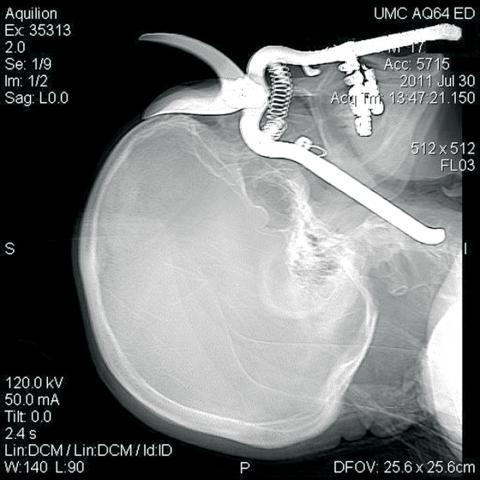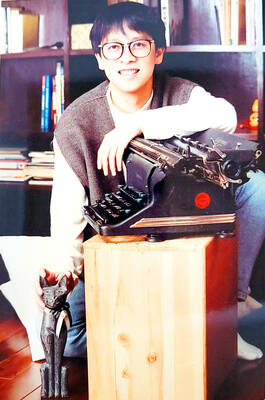An 86-year-old American has made a stunning recovery after a gardening accident left him with a pair of pruning shears impaled through an eye socket deep into his skull.
Leroy Luetscher lost his balance and fell face-down on the shears, which had landed point-end down in the ground when he dropped them at his home in Green Valley, Arizona.
“It was excruciating. I just can’t tell you how much it hurt ... I thank my lucky stars that I’m here,” he told a news conference at the University Medical Center in Tucson.

Photo: AFP
照片:法新社
An X-ray released by the hospital shows the garden implement impaled through his right eye, with the handle stuck 15cm down inside his skull.
But all that remains of the July 30 accident is some slight swelling of his upper and lower lids and minor double vision in the affected eye, said Dr. Lynn Polonski, one of the surgeons who operated on him.
“You just wonder how the handle of the pruning shears got there. The handle was actually resting on the external carotid artery in his neck,” Polonski said.
“We decided we could safely remove the pruning shears. We are so happy that Mr. Luetscher did not lose his eye or any vital structures,” said the doctor, a clinical assistant professor of ophthalmology.
Trauma surgeon Julie Wynne described how, after removing the shears, she and other doctors rebuilt the socket with metal mesh and saved the octogenarian’s eye.
“You wouldn’t believe your eyes ... Half of the pruning shears was sticking out and the other half was in his head,” she said.
Luetscher’s girlfriend Arpy Williams, who called 911 after the accident, said: “I was just shocked. There was blood all over ... I saw this instrument in his face, and I just said ‘Leroy honey, what have you done?’”
(AFP)
美國一位八十六歲老翁,意外被修枝剪刺穿其眼窩並深入顱骨,復原狀況卻是神乎其神地好。
勒魯瓦‧路契爾將修枝剪刀尖端插入其位於亞歷桑納州綠谷家的地面後,他一個重心不穩,正臉跌向剪刀把手上。
他在圖森大學醫療中心的一場記者會上說:「當時簡直是痛不欲生。我難以形容有多痛…真慶幸我福星高照,還能在這裡。」
一張院方公布的X光片,可見園藝工具刺穿老翁右眼,而長達十五公分的剪柄,就這麼硬生生的深入其顱內。
其中一位操刀的醫師霖恩‧波隆斯基表示,這場七月三十日令人驚駭的意外,留下的症狀卻僅是老翁上下眼皮的些微腫脹,以及該眼輕微的複視。
波隆斯基說:「當時你只納悶這把修枝剪是如何卡入頭內。剪柄竟正巧停在其頸部的外頸動脈上。」
這位醫師也是眼科臨床助理教授說:「我們認為可以安全地移除這把修枝剪。我們對於路契爾先生並未失明,也沒有損及體內重要構造,甚感欣慰。」
創傷外科醫師裘莉‧偉恩在移除這把剪刀後,描述她與其他醫師是如何以金屬網重建眼窩,並且保住這位八旬老翁的靈魂之窗。
她說:「你不敢相信眼前所見的…修枝剪有一半外露,而另一半則在他頭內。」
事發當時打電話向九一一求救的是路契爾的女友阿比‧威廉斯,她描述當時狀況說:「我簡直嚇呆了。當時到處是血…我看見這個工具在其臉內,而我只說:『親愛的勒魯瓦,你做了什麼?』」
(法新社/翻譯:林亞蒂)

For many people in Taiwan, childhood memories of rural life include pig pens standing beside family homes. Leftover rice, vegetable scraps and soup from daily meals were poured into buckets and fed to pigs. This practice of feeding pigs with household food waste was once a common way of life, both an economic choice and an expression of agricultural society’s deep respect for conserving resources. From a practical standpoint, pigs are omnivorous animals capable of efficiently digesting food scraps that humans can no longer eat. For rural households, food waste cost almost nothing, yet it could be converted into pork, a

A: Apart from the Taipei Music Center’s exhibit and concert, US pop rock band OneRepublic and rapper Doja Cat are touring Kaohsiung this weekend. B: OneRepublic is so popular that after tonight’s show at the K-Arena, they are set to return to Taiwan again in March next year. A: And Doja will also perform at the same venue on Sunday, right? B: Yup. Her collab with Blackpink’s Lisa and singer Raye for the song “Born Again” has been a huge worldwide success. A: Doja even made it on Time magazine’s “100 Most Influential People” list in 2023. She’s so cool. A: 本週末除了北流的特展和演唱會外,美國男團共和世代和饒舌歌手蜜桃貓朵佳也將來台開唱。 B: 共和世代因太受歡迎,繼今晚高雄巨蛋的演唱會後,預計明年3月即將再度來台巡演唷。 A: 朵佳本週日將在同場地開唱,對不對?

Tango unfolds in a dimly lit room, where a haunting melody ushers two dancers into a close embrace. Here, music and movement merge into a silent yet passionate conversation, expressing longing, memory and shared purpose. What makes tango truly magical is the deep interaction and spontaneous improvisation between partners. Tango began in the late 19th century in Buenos Aires, Argentina’s bustling capital. Born in the poor working-class neighborhoods and busy port areas, this dance emerged from a melting pot of cultures. European immigrants, African slaves and local residents all contributed to its unique character. From these rich influences, tango

A: What show are you watching online? B: I’m watching “Fly Me to the Moon & Back” – an exhibition launched by the Taipei Music Center (TMC) to commemorate the late singer Tom Chang. A: Known for his sky-high notes, Chang is praised as one of the best singers in the 1990s. His death at the age of 31 was a major loss indeed. B: And I’m so glad that we went to the TMC’s 90s-themed concert last Friday. I finally saw the iconic “Godmother of Rock” WaWa perform live. A: This year-end show also featured singers Princess Ai, Bii, Wayne Huang, PoLin and